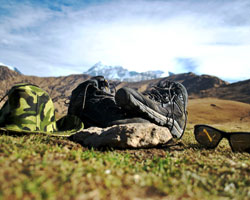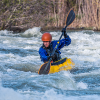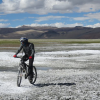The FIRST AID modules provide information on caring for injuries and sickness in a backcountry environment when you are hours or even days away from definitive medical care, with focus on what is commonly encountered in the mountains. These modules only provide an overview, but are not meant as adequate instruction for beginners. While traveling in remote, wilderness areas ensure you group includes qualified wilderness medicine professionals, or get a WFA, WAFA or WFR certification yourself.
Cold injuries occur when the skin is damaged by cold due to direct or indirect contact. Frostnip, frostbite and trenchfoot are discussed in detail below.
FROSTNIP
Frostnip is temporary near-freezing of epidermal (top, superficial layer of the skin) tissues, especially the nose, cheeks, fingers and toes.
Signs and Symptoms
- Pain
- Tingling
- Numbness
- White, waxy skin
Treatment
- Replace any wet clothing with warm, dry clothes.
- Place cold hands in groin or armpits, put feet on a partner’s abdomen, use warm hands to cover nose and cheeks.
- Prevent further exposure. This area will be more susceptible to future cold injury.
FROSTBITE
Frostbite is the freezing of tissues, especially at the extremeties. Frostbite can range from superficial (epidermis and dermis damage only) to full thickness freezing.
Signs and symptoms
- Superficial:
Before re warming: Pale, numb skin and pliable tissue
After re warming: Blisters extending to the tips of toes/fingers
- Full thickness
Before re warming: Skin will be hard, white, waxy, numb, sometimes burgundy-black
After re warming: Late-forming dark blisters which do not extend to the tips on completely frozen extremities.
Treatment
- Superficial Frostbite
- Water bath: Place the affected extremity in a warm water bath between 37° - 39° C for at least 30 minutes, until circulation is restored. Avoid any direct contact with the container, and expect the bath to be very painful.
- Body-to-body rewarming: Place frostbitten hands against the skin in armpits or groins. Place bare, frostbitten feet on a partner’s abdomen. Do not rub.
- Protect: Protect the injury from pressure, friction, trauma, and re freezing. Wrap the affected extremities loosely in a bandage or clothes.
- Ibuprofen: For pain and inflammation.
2. Full-thickness Frostbite
- Leave frozen if there is possibility of re-freezing: Do not consider re-warming parts affected with full thickness frostbite unless evacuation will take many hours or days.
- Dress and insulate: Wrap the injured area with gauze sponges between fingers and toes, surrounding them loosely. Insulate the area with non cotton material and cover with a windproof or plastic layer.
- Protect: Protect the injury from pressure, friction, trauma and re freezing.
- Do not warm with fires. This will most likely burn the tissue. Do not break blisters. Do not rub.
- Do not allow re freezing, in case spontaneous thawing occurs.
- Evacuate: All full thickness frostbite injuries should be evacuated immediately. For recovery of an affected extremity, advanced medical care must be provided with the first 12-24 hours. During evacuation, re-warmed tissue could freeze again, while frozen tissue could thaw spontaneously in case you decide to withhold rewarming. This cycle further damages the tissue, and draws heat from an already weak body, which could further lead to hypothermia.

TRENCHFOOT
Trenchfoot is a non freezing injury cause by prolonged exposure to cold and wetness. This results in vasoconstriction, decreased circulation and skin cell death.
To prevent trench foot during long expeditions, allow feet to dry every night. Reserve one pair of dry socks for sleeping. Dry wet socks in your sleeping bag overnight. Foot powder can be helpful.
Signs and Symptoms
- Symptoms develop after 4 or more days.
- Cold, swollen and waxy feet with burgundy - blue spots
- Feet later become red and hot with blisters
Treatment
- Remove wet socks and allow feet to dry out.
- Dry boots out.
- Protect from freezing injuries.
- Ibuprofen for pain and inflammation.
HYPOTHERMIA
Hypothermia is defined as the dropping of core body temperature below 95F or 35°C. As the body gets cold, we start shivering, the skin turns cold and blue, and we lose fine motor skills. These are the early signs, which mean the body is diverting circulation from the extremities to the vital organs. Failure to mitigate these symptoms leads to severe hypothermia.
Prevention
Stay well-fed and hydrated. Maintain energy reserves and plan all your outdoor trips well with the possibility of unexpected exposure to extreme cold, especially at high altitudes. Watch out for early signs. Be careful about the following factors that increase susceptibility to hypothermia:
- Dehydration
- Exhaustion
- Acute, short-term malnutrition
- Immobilzation due to injury
- Alcohol
- Impaired shivering
- Burns
- Extremes of age
- Lack of cold adaptation
- Spinal injuries or other CNS (central nervous system) injuries
- Diabetes
Stages
Hypothermia is classified in hospitals based on body core temperature. However, temperatures obtained in the backcountry may be inaccurate and we classify stages based on the ability to shiver.
- Mild: The patient can still shiver. Core temperature below 95 F or 35° C
- Severe: Shivering ceases. Core temperature below 85F or 28° C
Signs and Symptoms
- Mild Hypothermia
1. Shivering
2. Confusion, poor decision making
3. Poor motor skills
4. Lethargy
5. Combativeness/Irritability
6. High respiratory rate and pulse
- Severe Hypothermia
1. Loss of shivering
2. Unresponsiveness
3. Dilated or fixed pupils
4. Loss of motor skills
5. Slow respiratory rate and pulse
Treatment
- Mild Hypothermia
1. Get out of the cold and protect from wind.
2. Remove wet clothes.
3. Consume simple sugars, preferably in liquid.
4. Prevent further heat loss and create a warm environment
- Severe Hypothermia
1. Handle gently. People suffering from sever hypothermia are prone to cardiac arrest.
2. Remove from exposure and prevent further heat loss.
3. Create a warm environment by wrapping in sleeping bags, jackets, foam mats and covering with windproof material like tarps.
4. Consider adding heat (hot water bottles, warmees, heat packs) to the core, hands and feet (NOT to neck, armpits or groin)
5. Evacuate immediately for advanced life support and definitive medical care.



















